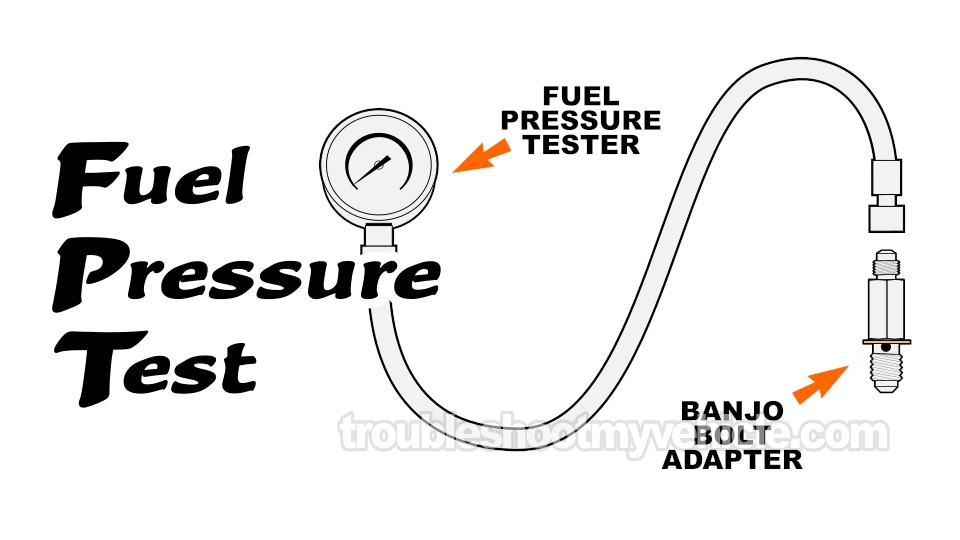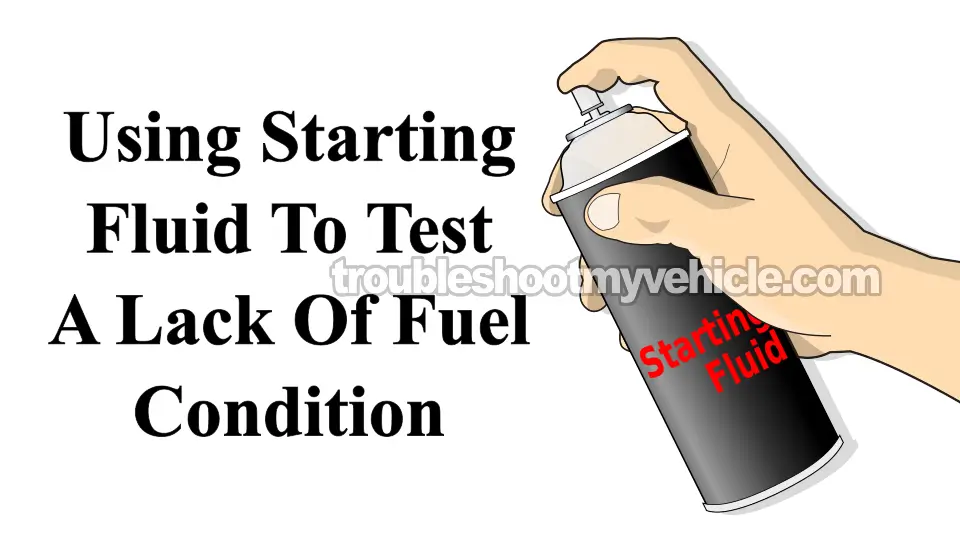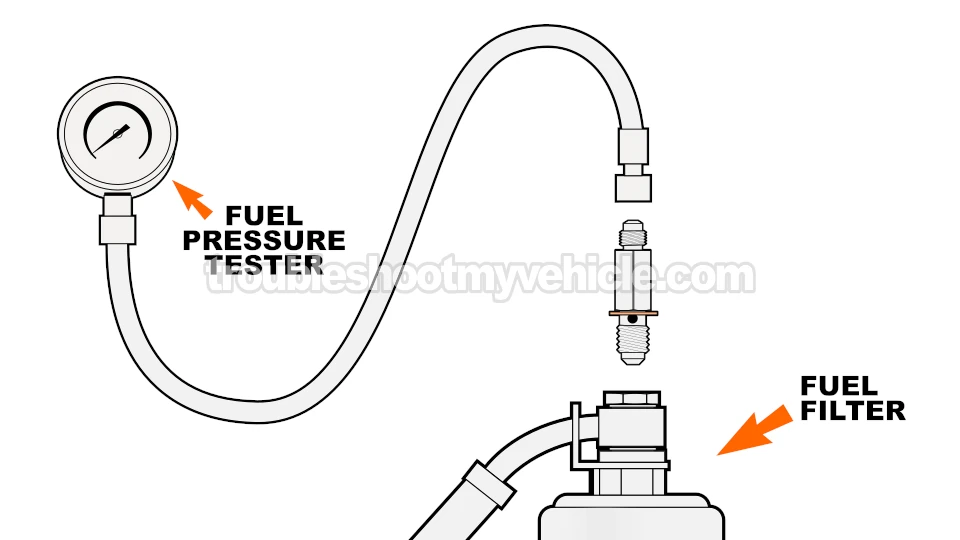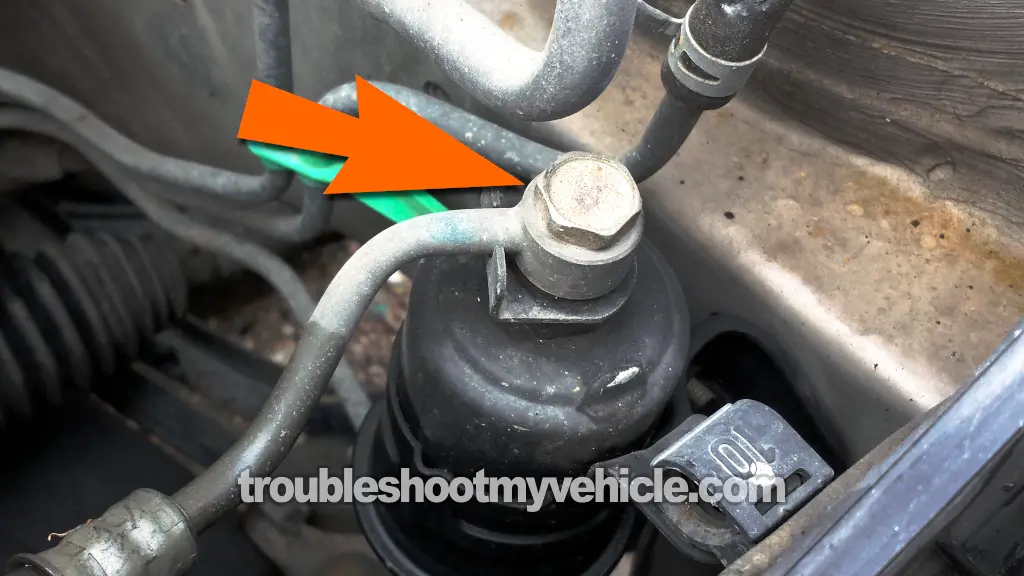
If your Toyota Corolla's not starting or running rough and you think the fuel pump's the problem, a fuel pressure test with a fuel pressure test gauge is the best way to find out.
The best part? Testing the fuel pump with a fuel pressure test gauge on the 1993-1996 1.6L Toyota Corolla's pretty easy.
In this guide, I'll show you how to set up the gauge, what readings you need to see, and a simple starting fluid trick to check if zero fuel pressure is keeping the engine from starting.
Contents of this tutorial:
APPLIES TO: This tutorial applies to the following vehicles:
- 1.6L Toyota Corolla: 1993, 1994, 1995, 1996.
- 1.6L Geo Prizm: 1993, 1994, 1995, 1996.
Engine No-Start Diagnostics:
Toyota Fuel Pump Test Tutorials:
- How To Test The Fuel Pump (1989-1992 1.6L Toyota Corolla).
- How To Test The Fuel Pump (1997 1.6L Toyota Corolla).
Wiring Diagrams:
- Fuel Pump Circuit Wiring Diagram (1993 1.6L Toyota Corolla).
- Fuel Pump Circuit Wiring Diagram (1994-1995 1.6L Toyota Corolla).
- Fuel Pump Circuit Wiring Diagram (1996-1997 1.6L Toyota Corolla).
Symptoms Of A Bad Fuel Pump
Fuel pumps usually fail in one of two ways:
- Sudden death: The pump stops working and the engine cranks but doesn't start.
- Gradual decline: It still runs and supplies enough fuel to get the engine started but as soon as you stick the transmission in drive and step on the gas pedal, engine performance suffers.
If your 1.6L Toyota Corolla's fuel pump goes bad, you're gonna notice:
- Engine won't start: The engine cranks when you turn the key, but it won't fire up.
- Spark test confirms spark: A spark test shows all cylinders are getting spark, so the ignition system's not the issue.
- Fuel injectors activated: A Noid light test proves the fuel injection computer's sending activation signals to the injectors.
- Zero pressure reading: If your fuel pressure gauge reads zero, the pump's dead.
- Engine starts briefly with starting fluid: Spraying starting fluid into the throttle body and cranking the engine makes it start for a few seconds before dying again.
If your fuel pump's failing and not doing its job right, you're gonna notice at least one of these symptoms:
- Your car throws lean air-fuel mixture trouble codes.
- The engine stumbles and idles rough.
- It takes forever to start —only fires up after a lot of cranking.
- When you step on the gas pedal, the engine feels weak and sluggish.
- Under load (like when you're flying down the highway), the engine backfires like crazy through the intake manifold.
The best way to check if your fuel pump's causing the no-start or messing with performance? A fuel pressure test with a gauge.
Where To Buy A Fuel Pressure Test Gauge
You're gonna need a fuel pressure test gauge to check if the fuel pump's doing its job —you can pick one up at an auto parts store or order it online.
These test kits are a solid deal since they come with adapters that work on your 1.6L Toyota Corolla. Plus, they've got GM and Ford owners covered too, as long as the fuel injector rails have Schrader valves.
Disclosure: As an Amazon Associate, I earn from qualifying purchases. If my tutorials help you, using these links is an easy way to support the site at no extra cost to you. Thank you!
NOTE: All of the fuel pump pressure test kits above have the fitting that will connect to your Toyota's fuel system.
TEST 1: Checking Fuel Pressure With A Fuel Pressure Gauge
Alright, let's test your 1.6L Toyota Corolla's fuel pump to see if it's dead or just starting to fail.
You'll need to connect a fuel pressure gauge to the output side of your Corolla's fuel filter.
The steps below will walk you through the whole process. Check out the illustration and photo above to spot the right connection points.
Here are the fuel pressure specs for the 1993-1996 1.6L Toyota Corolla:
| Engine Off and DLC terminals +B and FP jumpered. |
|---|
| 38-44 PSI |
| Engine running and w/out vacuum hose connected to fuel pressure reg. |
|---|
| 38-44 PSI |
| Engine running and w vacuum hose connected to fuel pressure reg. |
|---|
| 31-37 PSI |
NOTE: If you don't have a fuel pressure gauge, take a look at the section: Where To Buy A Fuel Pressure Test Gauge.
Fuel Filter Location: The fuel filter is located on the left (driver) side of the engine compartment, at the bottom of the strut tower.
Alright, here's how to test it:
- 1
Take off the top part of the air filter assembly and the air duct that connects it to the throttle body (so you can reach the fuel filter).
- 2
Wrap a shop towel around the fuel filter's union bolt (see photo 3 of 4 above).
The towel's there to catch any fuel that might leak, drip, or spray when you loosen the bolt, in case there's still pressure in the line. - 3
Remove the fuel filter's union bolt.
NOTE: Watch out for the two copper washers on the bolt. Don't let them drop into the engine bay —you'll need them when you put everything back together. - 4
Install the fuel pressure test kit's adapter where the union bolt was and tighten it up.
- 5
Find the diagnostic link connector (DLC) and connect terminals +B and FP using a jumper wire. See image 4 of 4.
Jumpering these two terminals makes the fuel pump turn on when you switch the key to ON in the next step. - 6
Turn the key to ON (but don't crank or start the engine).
NOTE: Check the adapter connection on your fuel pressure gauge for leaks. If you see any, turn the key OFF and fix them before continuing —leaks will mess up your reading. - 7
Your fuel pressure gauge should read between 38-44 PSI.
NOTE: You can also test fuel pressure while the engine's running. Just pull the jumper wire from the Data Link Connector, start the engine, and check the gauge. Use the tables above for the correct pressure specs.
Here's what your results mean:
CASE 1: The fuel pressure gauge reads 0 PSI. This confirms your 1.6L Toyota Corolla isn't starting because the fuel pump isn't sending fuel to the injectors.
CASE 2: The fuel pressure gauge shows the correct fuel pressure. This means the fuel pump's working fine and delivering enough fuel to the injectors.
If your Corolla still won't start, something else is causing the problem.
CASE 3: The fuel pressure gauge shows lower than the specified pressure (but not 0 PSI). This tells you the fuel pump's weak and starting to fail.
It's still pushing some fuel to the engine, but not enough for it to run properly. You'll need to replace the fuel pump.
TEST 2: Using Starting Fluid To Confirm Lack Of Fuel

One of the easiest ways to check if a lack of fuel is causing the engine no-start problem is by using starting fluid to see if the engine fires up for a few seconds.
I've done this test plenty of times —it's a super simple test and works like a charm! If the engine starts briefly, you'll know the no-start issue is caused by a lack of fuel from the pump. If not, you'll need to keep troubleshooting.
Before trying this, it's super important that you make sure all four cylinders are getting spark. Use a spark tester on each spark plug wire so you get an accurate test result.
IMPORTANT: After spraying starting fluid into the throttle bore, don't forget to snap the air intake duct back in place before cranking the engine. Even if you don't tighten the hose clamp, this prevents backfires from escaping through the intake manifold plenum.
Alright, let's do this:
- 1
Take off the intake air duct from the throttle body. No need to remove it completely —you'll be reconnecting it in a bit.
- 2
Hold the throttle plate open and spray starting fluid into the bore.
For safety, reconnect the air duct after spraying a good amount of starting fluid (no need to tighten the hose clamp just yet). - 3
Crank the engine once the air duct is back in place and you're clear of the engine bay.
- 4
You'll get one of two results:
1.) The engine starts, runs for a few seconds, then dies.
2.) The engine doesn't start at all.
Alright, let's break down what your results mean:
CASE 1: The engine started and ran for a few seconds. This confirms the no-start issue is caused by the fuel pump not supplying fuel.
I still recommend double-checking the fuel pump by measuring its fuel pressure with a gauge to be sure. Go to: TEST 1: Checking Fuel Pressure With A Fuel Pressure Gauge.
CASE 2: The engine didn't start at all. This usually means a lack of fuel isn't the reason your Corolla won't start.
Even in this case, I'd still run a fuel pressure test with a gauge just to rule out any fuel pump issues. Go to: TEST 1: Checking Fuel Pressure With A Fuel Pressure Gauge.
More 1.6L Toyota Corolla Tutorials
You can find a complete list of 1.6L Toyota Corolla tutorials and wiring diagrams in this index:
Here's a sample of the tutorials you'll find there:
- How To Test A Blown Head Gasket (1989-1997 1.6L Toyota Corolla).
- How To Test Engine Compression (1989-1997 1.6L Toyota Corolla).
- How To Test The Fuel Injectors (1993-1997 1.6L Toyota Corolla).
- How To Test The Throttle Position Sensor (1989-1997 1.6L Toyota Corolla).

If this info saved the day, buy me a beer!







